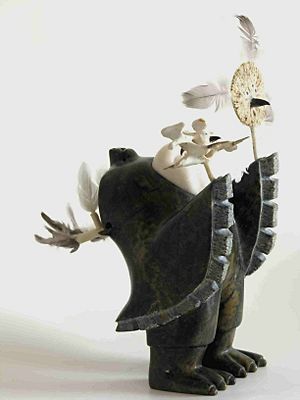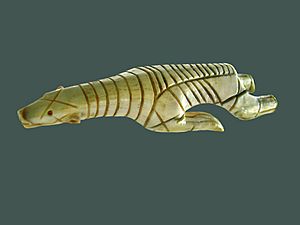Inuit art facts for kids

Inuit art, also called Eskimo art, is artwork made by the Inuit people. They live in the Arctic regions. Historically, Inuit artists often used walrus ivory for their carvings. Since 1945, when markets for Inuit art grew, prints and sculptures made from soft stones like soapstone have also become very popular.
The Winnipeg Art Gallery has the world's largest public collection of modern Inuit art. Another museum, the Museum of Inuit Art, opened in Toronto in 2007 but closed in 2016.
Contents
A Look Back in Time: History of Inuit Art
Ancient Art: Pre-Dorset and Dorset Cultures
Around 4000 BCE, nomadic people, known as the Pre-Dorset culture, traveled from Siberia across the Bering Strait. They moved into Alaska, the Canadian Arctic, Greenland, and Labrador. We know very little about them, and only a few ivory carvings remain.
The Dorset culture developed around 600 BCE. These people created many artworks from walrus ivory, bone, caribou antler, and sometimes stone. They carved birds, bears, walruses, seals, and human figures. They also made tiny masks. Dorset artists often carved bears and other animals with lines showing their bones. These are called "flying bears." These artworks were important for magic or religion. People wore them as amulets to protect against bad spirits or used them in their spiritual practices.
Ipiutak Culture: Detailed Designs
The Ipiutak culture created very detailed and fancy artwork. Their pieces included geometric shapes, animal figures, and human-like designs. This period shows a high point in early Inuit art.
Thule Culture: Ancestors of Today's Inuit
Around 1000 CE, the Thule people, who are the ancestors of today's Inuit, moved from northern Alaska. They either replaced or mixed with the Dorset people. Thule art showed influences from Alaska. They made useful items like combs, buttons, needle cases, and cooking pots. They also decorated spears and harpoons. The designs on these items were just for beauty, not for religious reasons. They wanted to make everyday objects look nice.
Inuit people made all their tools and weapons by hand. They used natural materials like stone, bone, ivory, antler, and animal hides. Since they were nomads, they carried very little with them. So, non-useful items were carved in small sizes. This way, they could be carried or worn. Examples include delicate earrings, dance masks, amulets, and small figures. These figures were used to tell legends and explain their religion and oral history.
European Contact: Art for Trade

In the 16th century, Inuit started trading with European whalers, missionaries, and other visitors. They traded for things like tea, weapons, or alcohol. Items that were once decorative tools or amulets for the angakkuq (shaman) became trade goods. These included carvings of animals and hunting scenes. Inuit artists also began making small ivory carvings just for trade. They even decorated European rifles, tools, and musical instruments. Cribbage boards and carved walrus and narwhal tusks were made for whalers. Missionaries also encouraged Christian art, which some Inuit artists used.
Modern Inuit Art: After 1945
Traditionally, Inuit carved objects for fun, games, religious purposes, or just to pass the time. But after Europeans arrived, the purpose of Inuit carvings changed quickly. This change sped up around 1949. That's when Inuit began to settle in communities. The Canadian government then started to encourage carving as a way for Inuit to earn money. The art changed a lot in size, materials, themes, and style from older traditions.
The Canadian government's push for commercial carving was quite strong at first. For example, in the early 1950s, they shared a pamphlet called "Eskimo Handicrafts." It showed artifacts from the Canadian Museum of History. Many of these items, like totem poles, were not part of Inuit culture.
The first Inuit artists in Kinngait (formerly Cape Dorset) sold their carvings to trading companies in the 1940s and 1950s. The West Baffin Eskimo Cooperative was started in Kinngait in 1959. It became the main buyer of arts and crafts from Inuit artists.
Types of Inuit Art
Block Printing: Making Art from Stone
James Archibald Houston helped bring attention to Inuit carving in the late 1940s. In 1951, he traveled to Kinngait (Cape Dorset) and taught artists about printmaking. Pictures of animals, hunters, family scenes, and myths became popular. By the 1960s, art co-operatives were set up in most Inuit communities. This helped the Inuit art market grow.
From 2018 to 2019, the University of Michigan Museum of Art showed Inuit block prints. The exhibit was called The Power Family Program for Inuit Art: Tillirnanngittuq. Tillirnannqittuq means "unexpected" in Inuktitut. The show featured famous artists like Kenojuak Ashevak and Lucy Qinnuayuak.
Since the early 1950s, some Inuit artists have used a smooth, realistic style. Other artists, like John Pangnark, have developed a very abstract style. Both styles often show traditional beliefs or animals.
Stone is a common material for block printing. Printmakers were often carvers, so they knew how to work with stone. In the mid-1980s, an artist named Iyola tried using slate from pool tables. Since then, this type of slate has been used for printmaking. Before that, local stones like steatite were used.
Making a print is a team effort between the printer (who carves the stone) and the artist. The printer makes some artistic choices for the final print. For example, if the original drawing has many thin lines, the printer might change it to make it easier to carve into the stone. Sometimes, parts of the drawing might be changed to fit the stone.
Drawing: Stories on Paper
Before James Houston arrived in the Arctic in the late 1940s, Inuit did not usually draw on paper. Artists began to create drawings and sell them to local co-operatives. These co-ops would then choose which drawings to turn into prints. Houston encouraged artists to draw about traditional Inuit life. Pitseolak Ashoona, from Kinngait, was one of the first Inuit artists to include her own life stories in her art. She greatly influenced her granddaughter, Annie Pootoogook. Annie's vivid drawings of everyday life in the North helped make Inuit art a modern art form.
Fashion: Art You Can Wear

Inuit clothing has always been a way for Inuit seamstresses to show their artistic skills. Historically, they used decorative techniques like ornamental trim, inlay, dyes, and pendants. They also used beadwork and special design motifs. They adapted new techniques and materials as they met other cultures.
Modern Inuit fashion is part of a larger movement of Indigenous American fashion. Today, Inuit designers use both modern and traditional materials. They create clothing with both traditional and new shapes. Many designers also make jewelry from local materials like bone. Fashion designer Victoria Kakuktinniq is a big influence in modern Inuit fashion. She focuses on parkas with traditional styles. Some designers highlight Inuit culture through their designs. They use prints with traditional tools, northern food products, and geometric patterns from traditional Inuit tattooing.
Sculpture: Carving from Nature
Inuit sculptures were made even before contact with the Western world. These early sculptures were small and made of ivory. In 1951, James Houston encouraged Inuit in Kinngait to make stone carvings. Mostly men started carving. Oviloo Tunnillie was one of the few women to become a nationally recognized sculptor.
Today, Inuit artists still carve pieces completely by hand. Sometimes, Power tools are used, but most artists prefer an axe and file. These tools give them more control over the stone. The last step is polishing, which involves using different grades of waterproof sandpaper and many hours of rubbing. The most common material now is soapstone or serpentine. These stones come in colors from black to light green. Some orange-red stone is imported from Brazil. Other materials used in Inuit sculptures include caribou antlers, ivory from marine mammals, and animal bones.
Inuit Art Society
The Inuit Art Society was started in 2003. Most of its members live in the Midwestern United States. Their goal is to teach people about and support the culture, art forms, and artists of the Arctic. They have about 100 members. Their yearly meetings include Inuit artists from Canada and experts on Inuit art and culture. They also have a marketplace where Inuit art can be bought.
Notable Inuit artists
- Manasie Akpaliapik
- Germaine Arnaktauyok
- Aron of Kangeq
- Karoo Ashevak
- Kenojuak Ashevak
- Pitseolak Ashoona
- Shuvinai Ashoona
- Siasi Atitu
- Alootook Ipellie
- Osuitok Ipeelee
- Josephina Kalleo
- Helen Kalvak
- Simeonie Keenainak
- Siassie Kenneally
- Ruben Komangapik
- Floyd Kuptana
- Andy Miki
- Annie Niviaxie
- Jessie Oonark
- John Pangnark
- Parr
- David Ruben Piqtoukun
- Peter Pitseolak
- Timootee (Tim) Pitsiulak
- Annie Pootoogook
- Kananginak Pootoogook
- Pudlo Pudlat
- Andrew Qappik
- Lissie Saggiak
- Pauta Saila
- Nick Sikkuark
- Joe Talirunili
- Tanya Tagaq
- Ningiukulu Teevee
- Irene Avaalaaqiaq Tiktaalaaq
- John Tiktak
- Simon Tookoome
- Ovilu Tunnillie
- Marion Tuu'luq
- Natar Ungalaaq
See also
- Alaska Native art
- Arctic Experience McNaught Gallery
- Art Gallery of Ontario
- North America Native Museum
- Inukshuk
- List of Inuit
- List of indigenous artists of the Americas
- List of Greenlandic artists
- Visual arts by indigenous peoples of the Americas



